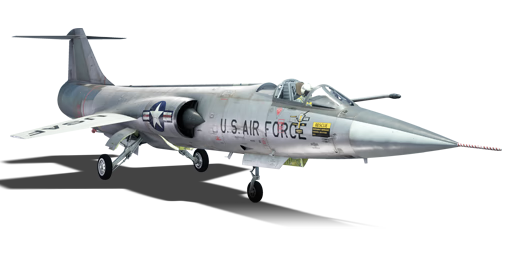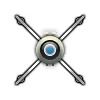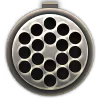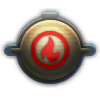



The F-104C mainly differs from early variants by being able to carry ground munitions. Although it may have seemed strange considering the overall unstable nature of the Starfighter, the Tactical Air Command decided to propose a ground striker version of the aircraft. Almost 80 F-104Cs were ordered and had its first flight in 1958. More orders were planned until Starfighter production was cancelled. Minor changes included an in-flight refuelling probe and a better fire control system. The F-104Cs saw service in Vietnam where they were soon replaced by the superior F-4D Phantom. The Starfighter always had a troubled history and the F-104C was no exception, despite the various improvements.
Introduced in Update "Starfighters", the F-104C is a sleek, fast jet also capable of carrying a decent bomb load and rockets. The main difference between the F-104C and F-104A is the ability to carry ground attack munitions like 750 lb bombs, FFAR Mighty Mouse rockets, and BLU-1 incendiary bombs. The F-104C also retains the ability to carry two AIM-9B Sidewinders and houses the improved M61A1 cannon. The F-104C is a dangerous aircraft at its battle rating but becomes hopelessly outclassed in uptiers due to the lack of flares and improved missiles.
flaps
flaps
flaps
brake
| Belt | Belt filling | Armor penetration (mm) at a distance: | |||||
|---|---|---|---|---|---|---|---|
| 10 m | 100 m | 500 m | 1000 m | 1500 m | 2000 m | ||
| HEF-I/API-T/AP-I | 40 | 36 | 22 | 12 | 6 | 3 | |
| HEF-I/HEF-I/API-T/HEF-I/HEF-I/AP-I | 40 | 36 | 22 | 12 | 6 | 3 | |
| API-T/AP-I/AP-I/AP-I/HEF-I | 40 | 36 | 22 | 12 | 6 | 3 | |
| HEF-I/AP-I/AP-I | 40 | 36 | 22 | 12 | 6 | 3 | |
| Name | Weight | Slot | ||||||
|---|---|---|---|---|---|---|---|---|
| 72.6 kg |  |  |  |  | ||||
| 19 × | 233.7 kg |  |  | |||||
| 362.4 kg |  |  |  | |||||
| 401.4 kg |  |  | ||||||












Flight performance | |
|---|---|
Survivability |
|---|
Weaponry | ||
|---|---|---|